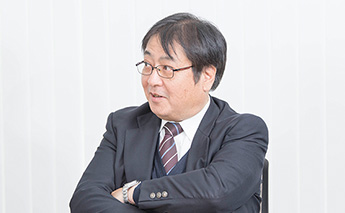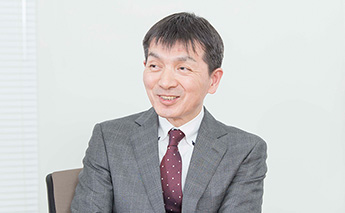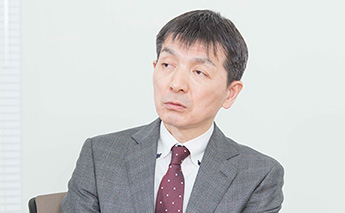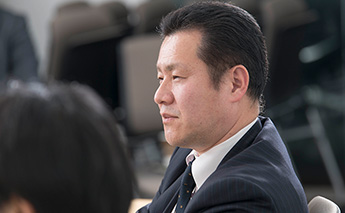Interview Date: March 2018
Partner Roundtable: Engineer Edition Part 1Engineers’ talk
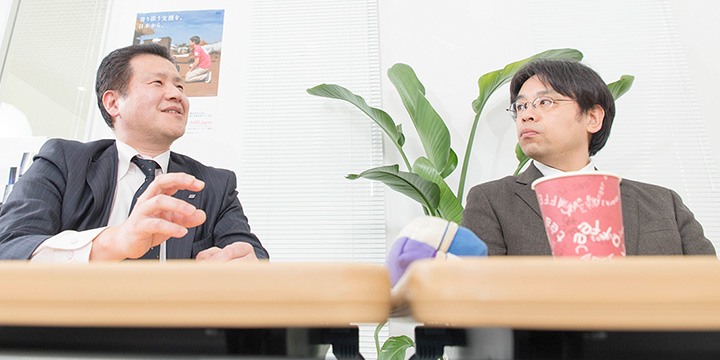
Pre-sales Activities of Engineers

Everyone gathered here today is involved not only in actual implementation support but also in pre-sales, right?
-
 UIS Hisaka
UIS Hisaka
-
That's right.
-
 JCS Matsuo
JCS Matsuo
-
In fact, I actively go out to business meetings myself.
What we do there is conduct demos (introducing the product by actually operating it) and conduct hearings, right?
-
 YJP Fukami
YJP Fukami
-
Basically, that's the case. Everyone, you are handed over from sales, right?
-
 MSI Oba
MSI Oba
-
Our sales team conducts simple demos from the initial stage. I only step in when inquiries arise. The sales team gathers information from the customer in advance, and I introduce it using a modeled version. It's like a stage before the prototype.
-
 KSI Ogura
KSI Ogura
-
Is it possible to gather such information at the initial sales stage?
-
 MSI Oba
MSI Oba
-
Of course, there are times when it can't be gathered. However, if we have a rough idea of the industry and product, we can shape it.
-
 KSI Ogura
KSI Ogura
-
In our case, we often start moving after receiving inquiries or introductions, so I often step in from the beginning. If the customer has a clear idea of what they want to do with the production scheduler, we make proposals accordingly. I also handle competitions, so I create demo projects based on the proposal requests we receive and explain them.
I think you also provide an estimated cost at the proposal stage. Is there anything you are careful about at that point?
-
 MSI Oba
MSI Oba
-
We always create a prototype at the proposal stage. We might be the only ones using it as the basis for the estimate. It helps us gauge the overall effort required for the implementation work.
-
 JCS Matsuo
JCS Matsuo
-
Our company basically pre-determines the integration grade according to the customer's needs. We broadly categorize it into three types and set a benchmark for estimates. After that, we re-estimate once the requirements are defined, but at that time, we think based on man-hours.
-
 YJP Fukami
YJP Fukami
-
This might be a bit off-topic, but our company often enters into quasi-delegation contracts based on man-hour consumption rather than fixed contracts, which is different from other companies.
-
 KSI Ogura
KSI Ogura
-
Indeed, fixed contracts increase the risk.
-
 YJP Fukami
YJP Fukami
-
That's part of it, but often at the initial requirements definition stage, customers can't fully express what is truly necessary for the design. When it's completed, it might not be what they intended. Instead, we take a quasi-delegation approach, progressing while confirming and aligning the requirements.
-
 UIS Hisaka
UIS Hisaka
-
Our company mostly uses fixed contracts, but in that regard, we take an agile approach by layering prototypes. Of course, it depends on the user.
-
 MSI Oba
MSI Oba
-
That's right. Our company has many small and medium-sized enterprise customers, so budgets are often limited, making quasi-delegation difficult.
-
 YJP Fukami
YJP Fukami
-
If our company uses fixed contracts, the project inevitably becomes a waterfall model. This poses a risk of progressing with a gap between what the customer truly wants and the requirements definition, so we mostly propose quasi-delegation contracts.
Points to Note in the Initial Introduction of FLEXSCHE from an Engineer's Perspective

Are there any difficult aspects in the requirements definition for FLEXSCHE?
-
 YJP Fukami
YJP Fukami
-
As I mentioned earlier,it's challenging when customers can't fully express their requirements during the requirements definition.That's right.
-
 MSI Oba
MSI Oba
-
It's common for the factory manager, on-site personnel, and planning staff to have different intentions.
-
 KSI Ogura
KSI Ogura
-
When you talk to the person in charge and submit the requirements definition document, sometimes the factory manager says something completely different. In such cases, you say, "I wrote it as you told me," but most of the time, the requirements definition has to be redone. This can lead to disputes, and eventually, you might be told, "Don't you have the ability to conduct hearings?"
-
 JCS Matsuo
JCS Matsuo
-
It's tough if there's no clear person to consolidate everything.
-
 UIS Hisaka
UIS Hisaka
-
We ask our customers to clarify their structure to some extent for the introduction. We ask who the person in charge is and who is responsible for the requirements. Having such a structure makes the process smoother. It's even better if executives can participate in the meetings.
-
 YJP Fukami
YJP Fukami
-
It's best if both the system person and the on-site person can attend the meetings. However, it's not easy to align the initial requirements definition with the customer's true intentions.
-
 MSI Oba
MSI Oba
-
When I visit customers, I always borrow a whiteboard and draw diagrams while asking questions. This helps deepen the customer's understanding, so if they later say something is different, it's clear where the difference lies. During the requirements definition stage, we pick a few points and create prototypes, but we have to keep digging into various constraints.
-
 KSI Ogura
KSI Ogura
-
That's right.The planning staff's mind should be filled with various constraints,butthey can't make them explicit in the form of requirements definition.That's right.
-
 MSI Oba
MSI Oba
-
The key is how to explore that.
-
 UIS Hisaka
UIS Hisaka
-
That's right. I try to think about what I would do if I were the planning staff.

Earlier, there was a mention of the user's side person in charge. What kind of structure do you often ask them to form?
-
 MSI Oba
MSI Oba
-
We ask them to assign a dedicated person for FLEXSCHE.However, in small and medium-sized enterprises, that can be difficult. At least initially, we want two people: a dedicated person and a backup.
-
 YJP Fukami
YJP Fukami
-
Introducing a production scheduler requires a tremendous amount of work, so having a dedicated person makes it smoother. It's tough to do it as a side job in between regular duties.
-
 KSI Ogura
KSI Ogura
-
Conversely, in large companies, the requirements definition tends to be formal, and direct meetings with the person in charge are often shallow. If the person in charge is not familiar with planning tasks, they can't judge whether the prototype is correct, so even if it's a burden,I definitely want to talk to the person who is actually doing the planning.
-
 JCS Matsuo
JCS Matsuo
-
It's important to have someone who knows the various circumstances well and can sit down and consult with us. Only then can we properly extract the requirements.
Is it possible to extract almost all requirements by proceeding with the requirements definition in that way?
-
 MSI Oba
MSI Oba
-
It depends on the case, but it's often difficult. Each factory has various constraints, so if you model and dig into each one, you can get most of them, but some still don't come out. Those are often only revealed at the very end of the implementation.
-
 KSI Ogura
KSI Ogura
-
As I mentioned earlier, even though the planning staff should know, they often can't clearly express it.
-
 YJP Fukami
YJP Fukami
-
After all,It is not always possible to cover everything in the requirements definition, so it is necessary to proceed while continuously confirming in an agile manner to prevent a large gap between what the customer envisions and what we are developing.I feel that way.
-
 MSI Oba
MSI Oba
-
Additionally, by showing the production site, we can sometimes see things that were not mentioned by the person in charge.
-
 KSI Ogura
KSI Ogura
-
That is something you can't do unless you are well-versed in the manufacturing industry, right?
-
 MSI Oba
MSI Oba
-
That's right. That's why I study hard and make sure to see various places within the factory.
The flexibility of FLEXSCHE
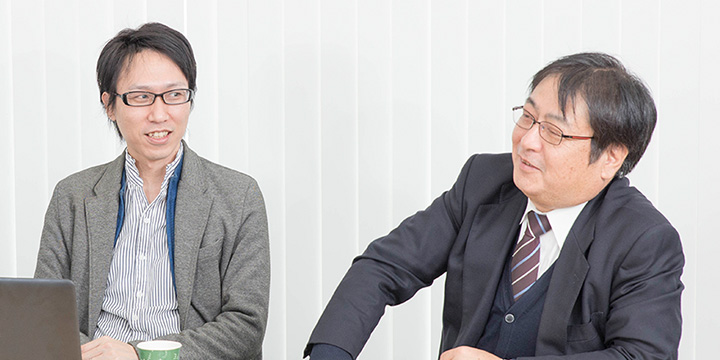
Everyone, you have been involved in the introduction of FLEXSCHE for over 10 years, but could you tell us about when you first started handling FLEXSCHE?
-
 MSI Oba
MSI Oba
-
At that time, I was asked by a customer for a production management system, but after listening carefully, I realized that what was needed was not a production management system but a production scheduler. I approached several companies, but I ultimately chose FLEXSCHE because its data interface is in an easy-to-handle format like CSV and can be flexibly customized, making it easy to integrate. Also, I realized after starting to use FLEXSCHE that there are many things that production management systems, which are implemented in many factories, cannot do.
How was the technical difficulty when you first started using it? There seems to be an image that the threshold is high...
-
 MSI Oba
MSI Oba
-
The mechanism itself is clear and very easy to understandI think. In the era of FLEXSCHE Components, it wasn't something that anyone could develop,but now you can do quite a lot with formulas,can't you?
-
 YJP Fukami
YJP Fukami
-
In the early days of FLEXSCHE, programming skills, especially in C++, were essential, but now, except for very special cases, there is no need for C++,and various things can be done easily,right?
-
 KSI Ogura
KSI Ogura
-
We had a predecessor in charge of FLEXSCHE, but there was a period after that person left and before I joined, so I had to do it without being taught the technical aspects, which was challenging. I think I progressed through self-study and was also trained by the customers.
-
 UIS Hisaka
UIS Hisaka
-
In my case, there was someone to teach me, so I was able to get into it smoothly at first. But as I delved deeper, I did face challenges.
-
 JCS Matsuo
JCS Matsuo
-
For me, it was a feeling of deepening through repeated prototyping in sales.
In the integration of FLEXSCHE, do you all also develop add-ins?
-
 YJP Fukami
YJP Fukami
-
Recently, the standard features have become quite comprehensive, so it has decreased significantly. Thanks to the command execution method in the scheduling rules, various things can be done.
-
 MSI Oba
MSI Oba
-
We also can do various things without adding many add-ins. Sometimes, when we want to use a feature available as an option, we solve it with a simple script.
-
 UIS Hisaka
UIS Hisaka
-
When you can do it with a script, the burden of add-in development is considerably reduced, isn't it?
Do you still develop DLL add-ins now?
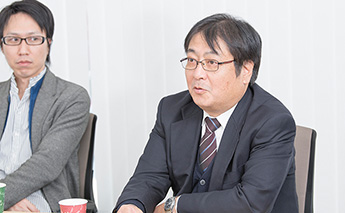
-
 MSI Oba
MSI Oba
-
We don't.
-
 YJP Fukami
YJP Fukami
-
We don't either.
-
 KSI Ogura
KSI Ogura
-
I do quite a bit. I create custom input screens for customers and make panels to facilitate searches.
-
 UIS Hisaka
UIS Hisaka
-
Indeed, there are cases where we create customer-specific screens.
-
 KSI Ogura
KSI Ogura
-
We also do a lot of report development. Sometimes we are asked to represent the Gantt chart image in spreadsheet software. Although it would be fine to print the Gantt chart as it is, we adjust it to include signature fields and such to fit the company's approval process.
It's about creating something that fits the unique culture of the users, isn't it?
-
 KSI Ogura
KSI Ogura
-
That's right. Doesn't everyone create reports?
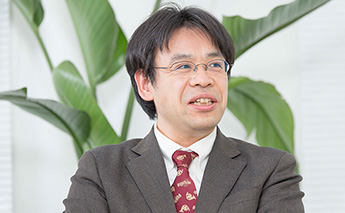
-
 JCS Matsuo
JCS Matsuo
-
We don't do much of that.
-
 MSI Oba
MSI Oba
-
We don't either.
-
 UIS Hisaka
UIS Hisaka
-
It's often done on the core system side.
-
 KSI Ogura
KSI Ogura
-
Oh, is that so (laughs).
What is necessary for smooth project progress

What are the reasons when a project stalls?
-
 KSI Ogura
KSI Ogura
-
It becomes a problem when we don't receive the master data from the customer,even when we ask for an approximate version, it doesn't come out easily, and the project has been suspended before.
-
 MSI Oba
MSI Oba
-
When you are passive, answers don't come easily, so we ask for the missing information, even if it's false. By scheduling, the lack of accuracy becomes apparent, which actually smooths the overall progress.
-
 YJP Fukami
YJP Fukami
-
Yes, that's good. When we were allowed to introduce it to a certain manufacturer, we gathered capability information and tried scheduling, and the people on the ground said, "This can't be right." We then made corrections and managed to realize it.
-
 KSI Ogura
KSI Ogura
-
Another pattern that prolongs the process is when the dedicated person changes due to various circumstances. The successor may have a completely different perspective from the first person, saying the opposite things. We have had to start over completely in the past.
-
 JCS Matsuo
JCS Matsuo
-
I also had a difficult time once when the person in charge changed seven times in a year. That project eventually fell through.
-
 UIS Hisaka
UIS Hisaka
-
Once a certain level of requirements definition is completed and sufficient information is gathered, development progresses,but reaching acceptance after starting test operations is the final hurdle,isn't it? About 10 years ago, there was a project where the test, which was supposed to be completed in a month, took a year. The condition was that if automatic scheduling could be done continuously for two weeks, acceptance would be granted, but it didn't go smoothly. At that time, the problem might have been starting development without sufficient requirements definition.
-
 KSI Ogura
KSI Ogura
-
I also had a time when acceptance wasn't granted. Previously, I was told, "We can't pay because the effect isn't visible yet," and I had to wait a year. Even though I made it according to the requirements (laughs). We made improvements from there, and eventually, after acceptance was granted, they wanted to implement it in another factory of the company, so it worked out somehow.
-
 UIS Hisaka
UIS Hisaka
-
Expanding horizontally like that means there was that much effect, right?
-
 KSI Ogura
KSI Ogura
-
At that time, I was still a beginner with FLEXSCHE and struggled with the project, but I think the various efforts we made allowed them to feel the effect.
-
 YJP Fukami
YJP Fukami
-
There are often cases where the person in charge is satisfied, but their superior doesn't acknowledge it.
-
 KSI Ogura
KSI Ogura
-
By the way, if you create according to the requirements and acceptance is granted but there are still issues remaining, how do you handle the costs?
-
 UIS Hisaka
UIS Hisaka
-
Basically, we receive additional payment.
I think the things users want to achieve using the production scheduler vary, but are there any difficult requests?
-
 MSI Oba
MSI Oba
-
It's not so much the requests, but often what the customer wants is not clear, which is challenging. We have to clarify it through trial and error. Also, since what each customer wants is different, we have to repeat this process every time, which is tough. Butwith FLEXSCHE, we can try planning with various conditions, so we can derive satisfactory results, which is helpful.
-
 KSI Ogura
KSI Ogura
-
Some customers ask to automate scheduling to be similar to their current plan...
-
 UIS Hisaka
UIS Hisaka
-
Since we are using FLEXSCHE for scheduling, I would like to rationally reconstruct the rules from scratch while retaining the essence of the excellent parts of traditional planning, and create a new production plan for the factory.
-
 MSI Oba
MSI Oba
-
That's the ideal, isn't it? In the first place,the plans that were originally made manually and the second-by-second schedules of FLEXSCHE are fundamentally different, so they shouldn't be compared.However...
-
 KSI Ogura
KSI Ogura
-
There are times when the original plan is so different that it cannot be accepted. However, I think it is unreasonable to aim for unconditional alignment in the first place.
-
 MSI Oba
MSI Oba
-
I always make sure to mention that. I try to convey at the initial stage, "By using this tool, you will create a completely different production plan than before."We propose how to change the current plan, recognizing that it is not perfect.That's right. Because it is a system that can contribute to business improvement from such an aspect, we have to create new answers.
-
 UIS Hisaka
UIS Hisaka
-
That includes a consulting element, doesn't it?
-
 MSI Oba
MSI Oba
-
That's right. Although we are not consultants, I intend to have that mindset.
-
 YJP Fukami
YJP Fukami
-
During the test operation phase, we schedule and ask the planner, "FLEXSCHE produced this result, but what would you do?" Sometimes operations are moved around, but we continue to ask on what basis they were moved. This allows us to uncover elements that were not fully defined in the requirements and sometimes even the planner's intentions come out.
-
 UIS Hisaka
UIS Hisaka
-
It's about parts that are not constraints for actual production, right?
-
 MSI Oba
MSI Oba
-
We want to incorporate such intentions into the system, but sometimes those intentions are too dominant, so honestly, it's difficult to get them to agree to operate FLEXSCHE.
-
 JCS Matsuo
JCS Matsuo
-
We want to create something more than just what was requested and make it something that can be used continuously.That's right.


